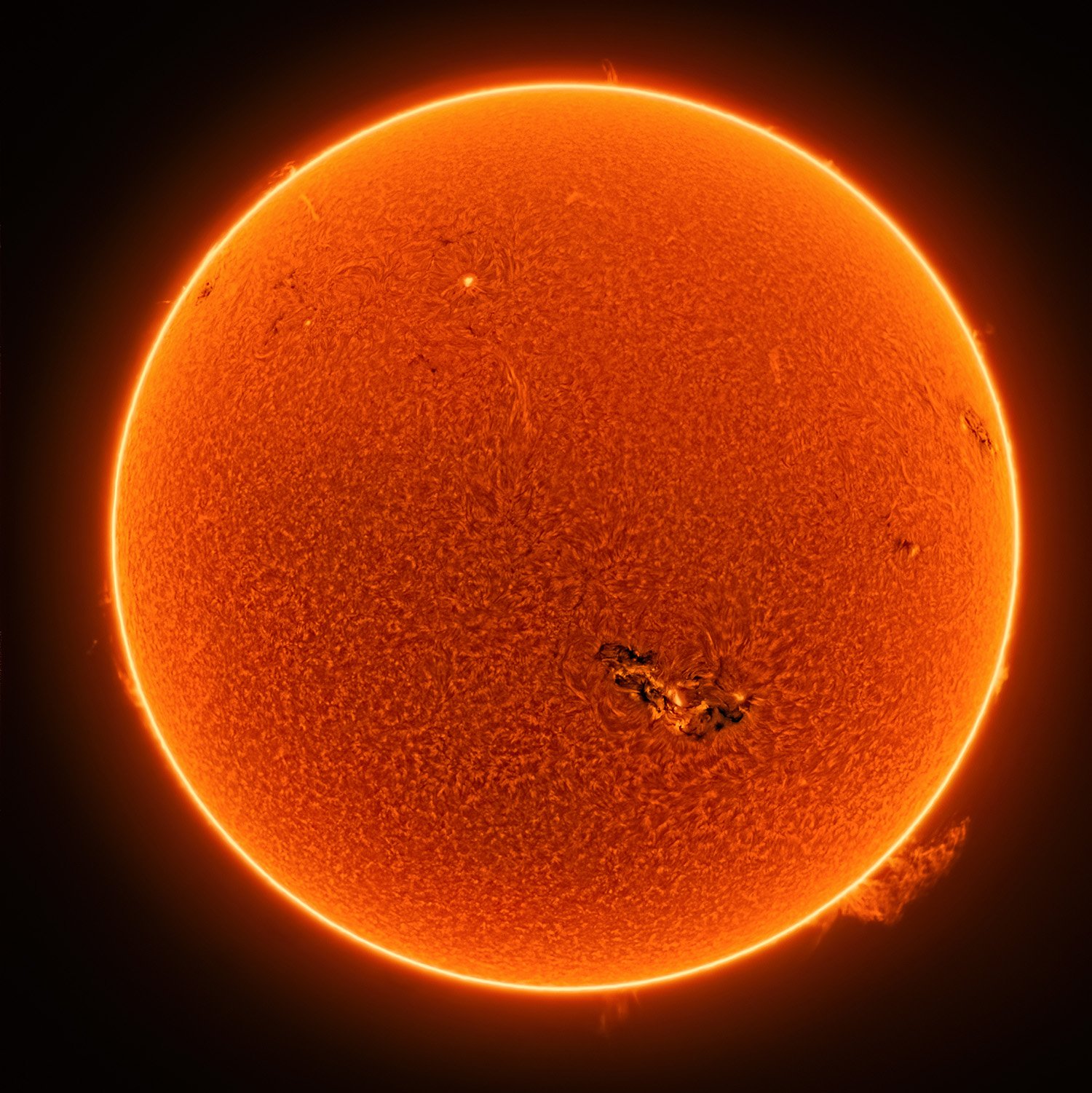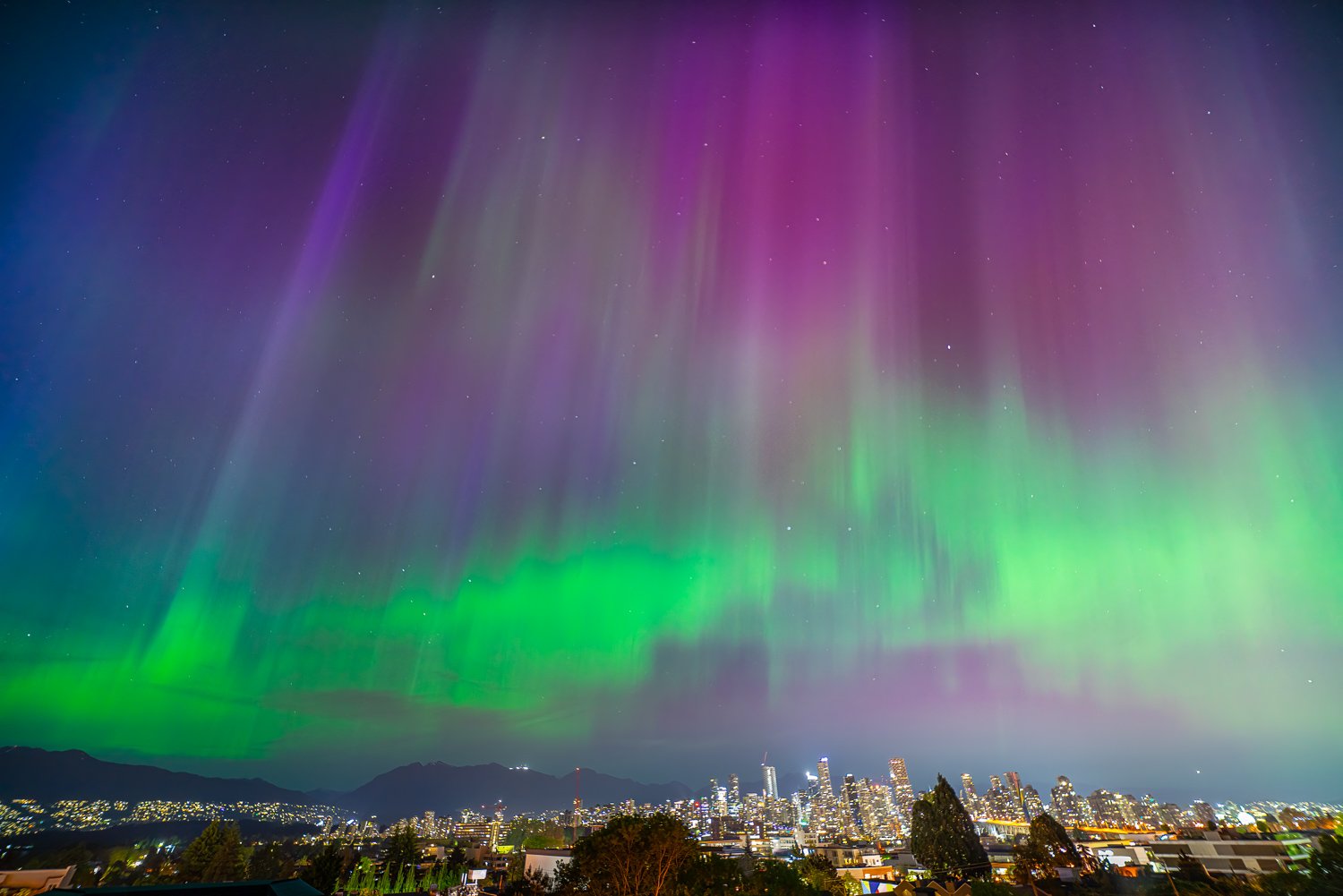The Northern Lights May 10th, 2024
In May 2024, a powerful solar storm delighted skywatchers with a spectacular display of the Northern Lights, or aurora borealis. The storm, caused by a significant coronal mass ejection (CME) from the Sun, led to a geomagnetic event that intensified the auroras, making them visible much farther south than usual. I was fortunate enough to photograph the solar storm on May 8th from my rooftop, and it was certainly the largest I have ever seen. We are approaching solar maximum, so this may be a signal that even more intense solar activity may be on its way.
The intense solar storm of May 8th, 2024 resulted in an extraordinary display of the northern lights two days later. Imaged with the Daystar Solar Scout 60DS and ASI533MM.
© Robert G. Lyons
Residents in regions like the northern United States and parts of Europe were treated to vibrant, dancing lights in the sky, with colors ranging from green and pink to red and purple. This solar storm was one of the strongest in recent years, sparking not only beautiful skies but also discussions on the impact of such events on satellite communications and power grids.
For those lucky enough to witness it, the event was a reminder of the Sun's dynamic nature and its ability to influence our planet in mesmerizing ways.
An extraordinary display of the northern lights dancing above the Vancouver skyline on May 10th, 2024. With vibrant greens, blues, purples, and reds, this was the finest dispay of the aurora borealis in over two decades. Sony A7R, Sigma 14mm f1.4, ISO 320, 1.6 seconds.
© Robert G. Lyons
The "corona" of the Northern Lights, also known as the auroral corona, is one of the most spectacular and awe-inspiring displays of the aurora borealis. This phenomenon occurs when the auroras are directly overhead, creating a crown-like effect in the sky. Here’s how it happens:
1. Viewing Angle: When the aurora is viewed from directly below, the light patterns converge towards a central point in the sky, resembling a crown or a halo.
2. Magnetic Field Interaction: Charged particles from the Sun collide with Earth's atmosphere, following the lines of Earth's magnetic field. These collisions emit light and create the aurora.
3. Dynamic Movement: The corona effect is dynamic and constantly shifting, with rays of light appearing to stream out from the central point, often moving rapidly and changing shape.
I actually had trouble finding the northern lights on May 10th, 2024 because they were not initially in the north where I expected to see them. It wasn’t until I looked directly up that I saw them. There was a giant arc crossing the sky from east to west and when I pointed my camera at it I was not dissapointed!
The auroral corona of the May 10th event. The effect is made even more dramatic by using the incredible Sigma 14mm f1.4 lens. With its ultra-wide perspective, the light rays are further intensified, adding depth to the image. Sony A7R, Sigma 14mm f1.4, ISO 800, 0.8 seconds.
© Robert G. Lyons
The auroral corona typically features a wide array of colors and fast-moving, intricate patterns, making it one of the most mesmerizing forms of the Northern Lights. It's a rare sight, usually observed in high-latitude regions, and offers a dramatic and immersive experience of this natural light show.
The diverse range of colours displayed in the northern lights are due to the charged particles from the sun interacting with elements in our atmosphere. Sony A7SIII with 35mm f1.4 GM, ISO 100, 5 seconds.
© Robert G. Lyons
The Northern Lights, or aurora borealis, display a variety of colors due to the interaction between charged particles from the Sun and Earth's atmosphere. The specific colors observed in the auroras are determined by the type of gas molecules involved and the altitude at which the interactions occur. Here’s a breakdown of the different colors and their causes:
1. Green:
- Cause: Oxygen molecules.
- Altitude: Around 100 km (60 miles) above Earth.
- Details: Green is the most common color seen in the auroras. When high-energy electrons collide with oxygen molecules at this altitude, the oxygen emits a greenish light.
2. Red:
- Cause: Oxygen molecules.
- Altitude: Above 150 km (95 miles).
- Details: Red auroras are less common and appear when high-energy particles interact with oxygen at higher altitudes. The energy level required to produce red light is higher than that for green.
3. Purple and Violet:
- Cause: Nitrogen molecules and ions.
- Altitude: Below 100 km (60 miles).
- Details: When energetic particles collide with nitrogen, they produce purple and violet colors. These colors often appear at the lower edges of the auroras and can blend with the greens and reds.
4. Blue:
- Cause: Nitrogen molecules.
- Altitude: Below 100 km (60 miles).
- Details: Blue is a rarer color that appears when energetic particles collide with nitrogen molecules at lower altitudes, where there is more energy available to produce blue light.
5. Pink:
- Cause: Combination of nitrogen and oxygen emissions.
- Altitude: Varies.
- Details: Pink auroras are a mix of red and blue or purple emissions, often appearing when different types of particles and energy levels interact simultaneously.
The beautiful colors of the aurora borealis are a direct result of these complex interactions in the upper atmosphere, creating one of nature’s most stunning light displays.
The auroral corona resembling going warpspeed into outer space. Sony A7R, Sigma 14mm f1.4, ISO 800, 1.6 seconds.
As we approach solar maximum, a period of peak solar activity in the Sun's 11-year cycle, several phenomena and effects can be expected:
1. Increased Solar Flares and Coronal Mass Ejections (CMEs):
- Solar Flares: These are sudden bursts of radiation from the Sun, which can impact communication and navigation systems on Earth.
- CMEs: These are large expulsions of plasma and magnetic field from the Sun’s corona. CMEs can lead to geomagnetic storms, which affect Earth's magnetosphere.
2. Enhanced Auroras:
- More Frequent and Intense Displays: The increased solar activity leads to more frequent and vibrant auroras (Northern and Southern Lights). These displays can be seen at lower latitudes than usual.
- Wider Visibility: Regions that typically do not see auroras may experience occasional sightings.
3. Impact on Satellites and Spacecraft:
- Increased Radiation: Higher levels of solar radiation can damage or disrupt the electronics of satellites and spacecraft.
- Orbit Decay: Enhanced solar activity heats Earth’s atmosphere, causing it to expand and increase drag on low-Earth orbit satellites, potentially altering their orbits.
4. Disruptions in Communication and Navigation Systems:
- Radio Signal Disturbance: Solar flares can cause radio blackouts, especially affecting high-frequency communications.
- GPS Signal Degradation: Increased ionospheric activity can interfere with GPS signals, leading to less accurate positioning.
5. Power Grid Vulnerabilities:
- Geomagnetic Storms: Intense geomagnetic storms induced by CMEs can create electrical currents in power lines, potentially damaging transformers and causing power outages.
6. Climate and Atmospheric Effects:
- Minor Weather Impacts: While the overall influence on climate is minimal, solar activity can slightly affect weather patterns and the ozone layer.
7. Increased Research and Monitoring:
- Scientific Observations: Solar maximum provides a valuable opportunity for scientists to study the Sun's behavior and its interactions with Earth.
- Space Weather Forecasting: Enhanced efforts to monitor and predict space weather events to mitigate their effects on technology and infrastructure.
Overall, the approach to solar maximum brings a mix of spectacular natural phenomena and challenges for technology and infrastructure, highlighting the dynamic relationship between the Sun and Earth. I eagerly anticipate more solar activity and I am standing by with telescopes and cameras ready!





